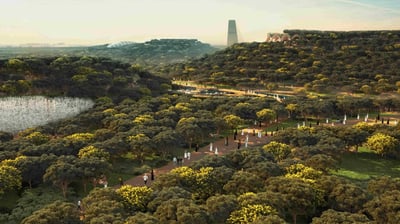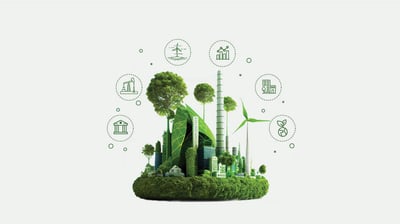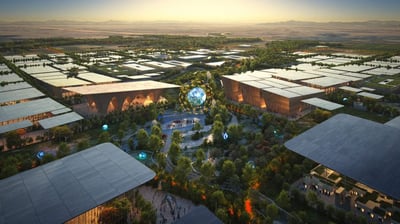A Sustainable EcoPark is designed as an innovative and eco-friendly space that integrates sustainability into every aspect of its operations and development. Such parks are focused on minimizing environmental impacts while promoting economic and social well-being. They serve as models for sustainable development, demonstrating how businesses, communities, and natural ecosystems can coexist harmoniously. Here’s an overview of what a Sustainable EcoPark typically involves:
Core Principles
Environmental Protection: Implementing green infrastructure and practices that preserve natural habitats, conserve water, reduce energy consumption, and minimize pollution.
Renewable Energy: Utilizing solar panels, wind turbines, and other renewable energy sources to power the park’s operations sustainably.
Waste Management: Employing advanced recycling, composting, and waste-to-energy technologies to achieve zero waste goals.
Sustainable Transportation: Encouraging the use of electric vehicles, bicycles, and public transportation, often facilitated by providing charging stations, bike paths, and shuttle services.
Green Building: Constructing facilities using sustainable materials and techniques, ensuring energy efficiency, water conservation, and reduced carbon footprints.
Economic and Social Dimensions
Economic Development: Fostering innovation and entrepreneurship through the creation of green jobs and support for eco-friendly businesses and startups.
Education and Research: Serving as a living lab for sustainability education, research, and demonstration projects, engaging both the public and academic institutions.
Community Engagement: Building strong connections with local communities through participatory planning, educational programs, and recreational activities that promote environmental stewardship.
Health and Well-being: Offering green spaces, parks, and recreational facilities that enhance the physical and mental health of visitors and residents.
Implementation Strategies
Comprehensive Planning: Integrating sustainability goals into all planning and decision-making processes, with a focus on long-term environmental, economic, and social benefits.
Innovative Technologies: Leveraging cutting-edge technologies for sustainable resource management, including water purification systems, smart energy grids, and IoT for monitoring environmental conditions.
Partnerships: Collaborating with government agencies, non-profits, businesses, and the community to pool resources, share knowledge, and multiply impacts.
Continuous Improvement: Committing to ongoing assessment and adaptation of practices to reflect the latest in sustainability science and technology.
A Sustainable EcoPark is more than just a physical space; it's a commitment to a philosophy of living and doing business that prioritizes the planet and its people. By embodying the principles of sustainability, such parks not only protect the environment but also offer viable paths toward economic resilience and social well-being, setting a standard for communities and industries around the world.
تم تصميم الحديقة البيئية المستدامة لتكون مساحة مبتكرة وصديقة للبيئة تدمج الاستدامة في كل جانب من جوانب عملياتها وتطويرها. تركز مثل هذه الحدائق على تقليل التأثيرات البيئية مع تعزيز الرفاهية الاقتصادية والاجتماعية. وهي بمثابة نماذج للتنمية المستدامة، حيث توضح كيف يمكن للشركات والمجتمعات والنظم البيئية الطبيعية أن تتعايش بشكل متناغم. فيما يلي نظرة عامة على ما تتضمنه عادةً الحديقة البيئية المستدامة:
المبادئ الأساسية
حماية البيئة: تنفيذ البنية التحتية والممارسات الخضراء التي تحافظ على الموائل الطبيعية والحفاظ على المياه وتقليل استهلاك الطاقة وتقليل التلوث.
الطاقة المتجددة: استخدام الألواح الشمسية وتوربينات الرياح وغيرها من مصادر الطاقة المتجددة لتشغيل عمليات المنتزه بشكل مستدام.
إدارة النفايات: استخدام تقنيات إعادة التدوير المتقدمة، والتسميد، وتحويل النفايات إلى طاقة لتحقيق أهداف الصفر من النفايات. النقل المستدام: تشجيع استخدام السيارات الكهربائية والدراجات ووسائل النقل العام، والتي يتم تسهيلها غالبًا من خلال توفير محطات الشحن ومسارات الدراجات وخدمات النقل المكوكية.
المباني الخضراء: بناء المرافق باستخدام مواد وتقنيات مستدامة، وضمان كفاءة الطاقة، والحفاظ على المياه، وتقليل آثار الكربون.
الأبعاد الاقتصادية والاجتماعية
التنمية الاقتصادية: تعزيز الابتكار وريادة الأعمال من خلال خلق فرص عمل خضراء ودعم الشركات والشركات الناشئة الصديقة للبيئة. التعليم والبحث: بمثابة مختبر حي لتعليم الاستدامة والبحث والمشاريع التجريبية، وإشراك كل من المؤسسات العامة والأكاديمية.
المشاركة المجتمعية: بناء روابط قوية مع المجتمعات المحلية من خلال التخطيط التشاركي والبرامج التعليمية والأنشطة الترفيهية التي تعزز الإشراف البيئي.
الصحة والرفاهية: توفير مساحات خضراء وحدائق ومرافق ترفيهية تعزز الصحة البدنية والعقلية للزوار والمقيمين.
استراتيجيات التنفيذ
التخطيط الشامل: دمج أهداف الاستدامة في جميع عمليات التخطيط وصنع القرار، مع التركيز على الفوائد البيئية والاقتصادية والاجتماعية طويلة المدى.
التقنيات المبتكرة: الاستفادة من أحدث التقنيات لإدارة الموارد المستدامة، بما في ذلك أنظمة تنقية المياه، وشبكات الطاقة الذكية، وإنترنت الأشياء لمراقبة الظروف البيئية.
الشراكات: التعاون مع الوكالات الحكومية والمنظمات غير الربحية والشركات والمجتمع لتجميع الموارد وتبادل المعرفة ومضاعفة التأثيرات.
التحسين المستمر: الالتزام بالتقييم المستمر وتكييف الممارسات لتعكس أحدث علوم وتكنولوجيا الاستدامة.
إن الحديقة البيئية المستدامة هي أكثر من مجرد مساحة مادية؛ إنه التزام بفلسفة العيش وممارسة الأعمال التي تعطي الأولوية للكوكب وسكانه. من خلال تجسيد مبادئ الاستدامة، فإن مثل هذه المتنزهات لا تحمي البيئة فحسب، بل توفر أيضًا مسارات قابلة للحياة نحو المرونة الاقتصادية والرفاهية الاجتماعية، مما يضع معيارًا للمجتمعات والصناعات في جميع أنحاء العالم.
Sustainable EcoPark






